Introduction, Specifications, Availability and Pricing
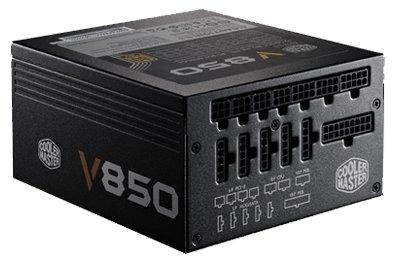
Back in May, Cooler Master launched their new line of flagship power supplies. We covered the launch of the V1000, which we found to be a perfect mix of performance, features and price to make it one of the best all around units that we have seen in a long time.
We understand that quite a few will find that a 1000W power supply is just frankly a bit much for their computing needs, so we felt that it was important to take a step down from the V1000 and see what else the V series had to offer.
Today we are looking at the V850. As the power supply is from the same series, there isn't much that differs. The V850 still sports a single 12V rail, along with full modular cabling. It is also still rated for 80 PLUS Gold efficiency and all of the protections are the same just as you would expect.
What has changed is the output of the unit and some of the connectors available on the unit. As you're probably curious as to just what has changed with the output of the unit, let's just get right into the specifications and start taking a look at the V850.
Specifications, Availability and Pricing

As you can see from above, the only thing that has changed as far as outputs are concerned when comparing the V850 to the V1000 is that there is less power available on the 12V rail. The 12V rail is rated for 70A or a total of 840W. Both the 3.3V and 5V rails are rated for 25A each with a maximum combined output of 125W. The 5VSB rail is rated for 3A or 15W total. Maximum combined output for the V850 is 850W.

Nothing changes between the V850 and V1000 when looking at the features. The V850 features SCP, OVP, OCP, OPP and OTP. The power supply is rated for 80 PLUS Gold efficiency. It features full modular cabling, all of which is fully sleeved or of the flat ribbon variety. Cooler Master does not rate the V850 for 100% continuous output at 50C, but rather it does so at a more modest 40C.
Cooler Master has an MSRP of $189.99 on the V850. Currently Newegg has the V850 on sale for $159.99. This makes the V850 a much more attractive offering and also makes it a bit more comparatively priced with the current competition. Cooler Master backs the V850 with a five year warranty.
Packaging
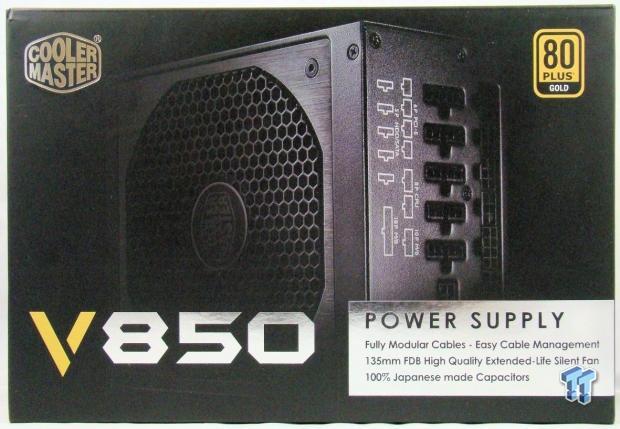
Cooler Master gives us just enough on the front of the box to let us know if this power supply might be what we are looking for by telling us that it is fully modular, has 100% Japanese capacitors and a 135mm fan.

The back is a bit lacking on information and doesn't really expand on the features much other than letting us know that it has a single 12V rail.

Turning to one of the sides we are presented with some details about the power supply including the I/O specifications.

The bottom points us to the CM website for more information, while the remaining two sides of the box simply display the V850 logo.
Inside the Box

The V850 is very well packed, so you can be sure that it is going to arrive without damage, unless the package is severely mishandled.
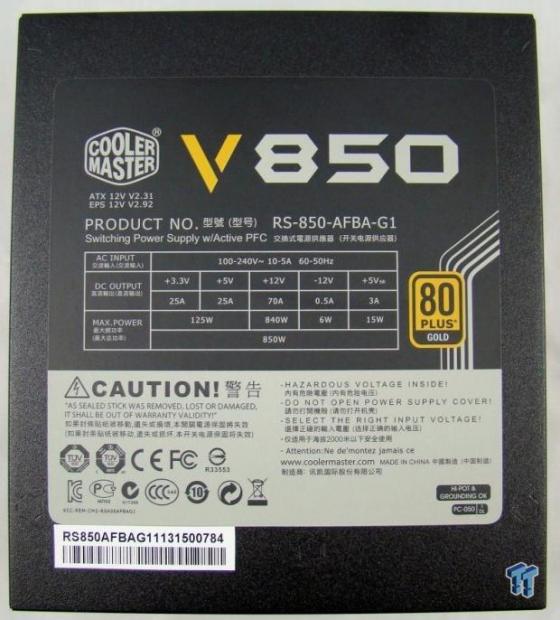
Looking at the top of the power supply, we find the I/O specification label as well as the serial number for the unit. We also catch a glimpse of the textured semi-gloss black finish on the unit.

Both sides feature the same logos with the opposite being inverted so that it can be installed in any orientation inside a case.

The back contains standard stuff as well with the honeycomb mesh grill, AC input and on/off rocker switch.

All of the modular connectors are labeled on the front of the unit. Also present is the Cooler Master logo, just for some added bling.

Flipping things to the bottom reveals the 135mm fan that cools the unit. It is surrounded with a brushed silver bezel to make it stand out a tiny bit.
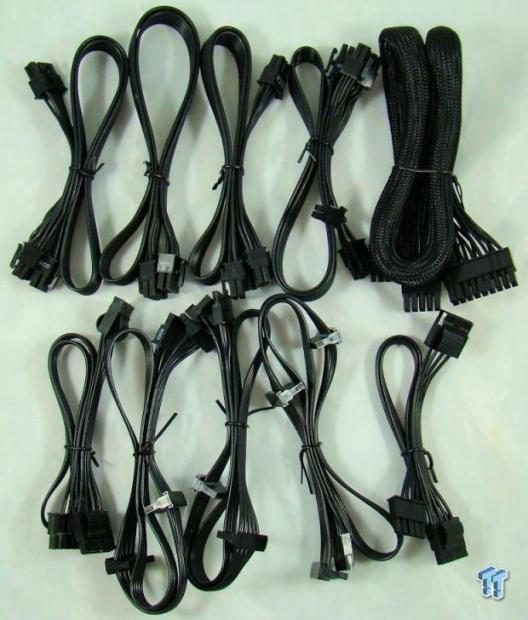
All of the modular cables are either fully sleeved or of the flat ribbon type.

Finishing the contents of the box is the AC input cord, mounting screws and user manual.
Cabling Arrangement and A Look Inside
Cabling Arrangement

The cables and connectors available for the V850 don't differ all that much from the V1000. As the only difference in power between the two units is on the 12V rail, it is quite logical that the only connector difference is in those that supply 12V power.
This means that we only have six PCI-E connectors instead of eight and we only have a single ATX 4+4 connector instead of two. Aside from those differences, there are still nine SATA, four Molex and a single FDD connector.

Rail distribution is as simple as it gets with a single 12V rail. There is no need to worry about load balancing here.
A Look Inside
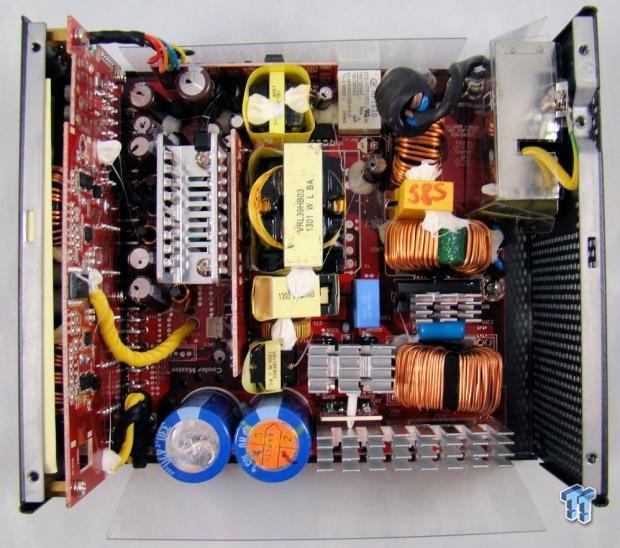
Seasonic manufactures the V series power supplies for Cooler Master and just by looking at the internals, it is easy to see some of their typical features, especially in the heat sinks. Component count is kept to a minimum to ensure that there is plenty of fresh air circulating all the way down to the PCB, allowing everything to stay as cool as possible.

A pair of Hitachi bulk capacitors sit on the primary side of the power supply.

The secondary side is littered with a bunch of Nippon Chemi-Con caps.

Cooler Master uses the MGA13512XF-O25 135mm fan to provide all of the active cooling for the V850 power supply.
Test Results and Final Thoughts
Test Results
Our load tests utilize a couple of FAST ATE active load testers and a variety of other equipment such as an oscilloscope, power conditioner, temperature probe and a power consumption meter. You can read more about our standard testing approach here.
The tests performed are based around six conceivable setups that are out there and progressively load down the PSU up to the power supply's limits or 1000W, whichever comes first. Since our test equipment's limits are higher than that of the Cooler Master V850 850W power supply, we can test it to the maximum.

The above tests represent typical loads that we have measured from various systems and are meant to give a rough idea of where your computer might fall in line with our tests. Please keep in mind that each system is different and actual loads can vary greatly even with similar hardware.

Let's start by taking a look at the voltages to see how well this unit did during testing. Starting with the 12V rail, we see 2% regulation from start to finish with a total drop of .09V. The 5V rail managed to stay within 2% of specification with a total drop of .06V from start to finish. Moving towards the 3.3V rail, we see that regulation was within 2% of specification with a total voltage drop of .03V.
DC Output quality for the Cooler Master V850 was good and well within specifications. During Test 1, we saw 13mV of noise on our scope. When we increased the loads in Test 3, the ripple climbed to 24mV at a little over half load. During Test 5 under a load of 850W, the oscilloscope showed a maximum of 36mV on noise on the 12V rail.
The Cooler Master V850 power supply is rated for 80 PLUS Gold efficiency. This means that the power supply must perform at 87%/89%/87% efficiency at 20%/50%/100% loads respectively. As you can see, V850 passed on our bench, and wasn't close to failing at any point.
Final Thoughts
Cooler Master's introduction of the V series power supplies was great to see, especially since it was a complete refresh in the flagship series of power supplies. As the V1000 was such a great unit all the way around in features, performance and price, we had the same expectations for the V850 that we have taken a look at today.
The V850 sports all of the same features and the performance is very close to that of the V1000 in Voltage regulation, DC output quality and efficiency, which is great to see. Unfortunately, the pricing of the V850 puts it in a bit of an awkward position on the market, especially considering what you can pick up the V1000 for right now. While the V850 has an MSRP of $189.99, you can pick it up for about $160 off of Newegg. The V1000 on the other hand has a higher MSRP, but can currently be had for $150 after a mail in rebate from Newegg as well.
It simply doesn't make any sense to spend more money and get less power with the same features from the same series of PSU.
Once the prices settle in a bit from the power supply still being somewhat fresh to the market, it may make a lot more sense to pick up the V850. Until then, the V1000 will remain a better option.

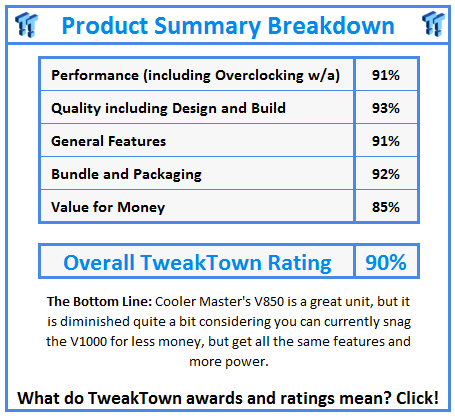
 United
States: Find other tech and computer products like this
over at
United
States: Find other tech and computer products like this
over at  United
Kingdom: Find other tech and computer products like this
over at
United
Kingdom: Find other tech and computer products like this
over at  Australia:
Find other tech and computer products like this over at
Australia:
Find other tech and computer products like this over at  Canada:
Find other tech and computer products like this over at
Canada:
Find other tech and computer products like this over at  Deutschland:
Finde andere Technik- und Computerprodukte wie dieses auf
Deutschland:
Finde andere Technik- und Computerprodukte wie dieses auf